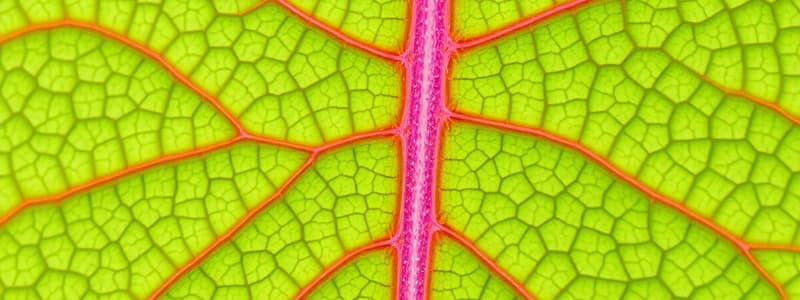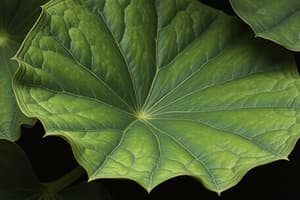Podcast
Questions and Answers
Which environmental factors primarily influence the shape and structure of leaves across different plant species?
Which environmental factors primarily influence the shape and structure of leaves across different plant species?
- Soil pH and nutrient availability.
- Climate, available light, grazing animals, and ecological competition. (correct)
- Altitude and wind patterns.
- Proximity to water sources and soil composition.
In dicotyledonous plants, what is the most common leaf shape, and what structures form its 'handle' and 'bowl'?
In dicotyledonous plants, what is the most common leaf shape, and what structures form its 'handle' and 'bowl'?
- Elongated; stipule and leaf vein
- Flattened spoon; petiole and leaf blade (correct)
- Rounded; leaf base and leaf margin
- Triangular; leaf apex and midrib
What advantage does a petiole provide to a leaf?
What advantage does a petiole provide to a leaf?
- Protects the leaf from insect damage.
- Provides structural support to the stem.
- Enables the leaf blade to track the sun, provides flexibility in wind, and optimizes blade spacing for sunlight. (correct)
- Increases the leaf's water storage capacity.
If a leaf lacks a leaf stalk, how is it described?
If a leaf lacks a leaf stalk, how is it described?
What is the primary difference in venation pattern between monocotyledons and dicotyledons?
What is the primary difference in venation pattern between monocotyledons and dicotyledons?
Which characteristic distinguishes a compound leaf from a simple leaf?
Which characteristic distinguishes a compound leaf from a simple leaf?
How can you differentiate leaflets from individual leaves on a plant?
How can you differentiate leaflets from individual leaves on a plant?
What term describes the arrangement of leaves on a stem, which is crucial for optimizing light exposure?
What term describes the arrangement of leaves on a stem, which is crucial for optimizing light exposure?
Which of the following leaf adaptations helps plants in dry climates reduce water loss?
Which of the following leaf adaptations helps plants in dry climates reduce water loss?
What is the function of translucent windows in the leaves of some plants like Fenestraria?
What is the function of translucent windows in the leaves of some plants like Fenestraria?
How do certain plants utilize aromatic oils and crystalline minerals in their leaves?
How do certain plants utilize aromatic oils and crystalline minerals in their leaves?
What primary function do scale leaves serve on plants?
What primary function do scale leaves serve on plants?
What defines a bract in botanical terms?
What defines a bract in botanical terms?
In Restio plants, what part of the plant primarily performs photosynthesis, and why?
In Restio plants, what part of the plant primarily performs photosynthesis, and why?
What unique characteristic defines succulent leaves?
What unique characteristic defines succulent leaves?
What distinguishes a phyllode from a typical leaf?
What distinguishes a phyllode from a typical leaf?
What is a cladode?
What is a cladode?
How do insectivorous plants supplement their nutrient intake?
How do insectivorous plants supplement their nutrient intake?
What is the primary mechanism by which active traps in insectivorous plants, like Venus flytraps, capture their prey?
What is the primary mechanism by which active traps in insectivorous plants, like Venus flytraps, capture their prey?
In what way do stipules get modified into thorns?
In what way do stipules get modified into thorns?
Flashcards
Leaf Definition
Leaf Definition
An organ of a vascular plant, defined in botanical terms, important in plant morphology.
Dicotyledonous leaf shape
Dicotyledonous leaf shape
Leaf shape is that of a flattened spoon with leaf stalk forming a handle, leaf blade represents bowl.
Sessile Leaves
Sessile Leaves
Leaves without a leaf stalk.
Dicot leaf vein types
Dicot leaf vein types
Signup and view all the flashcards
Monocotyledons leaves
Monocotyledons leaves
Signup and view all the flashcards
Compound Leaf
Compound Leaf
Signup and view all the flashcards
Odd Pinnate Leaf
Odd Pinnate Leaf
Signup and view all the flashcards
Even Pinnate Leaf
Even Pinnate Leaf
Signup and view all the flashcards
Nodes
Nodes
Signup and view all the flashcards
Phyllotaxy
Phyllotaxy
Signup and view all the flashcards
Leaf margin
Leaf margin
Signup and view all the flashcards
Bundle sheath
Bundle sheath
Signup and view all the flashcards
Leaf's Photosynthesis Role
Leaf's Photosynthesis Role
Signup and view all the flashcards
Leaf's Transpiration Role
Leaf's Transpiration Role
Signup and view all the flashcards
Bract
Bract
Signup and view all the flashcards
Scale Leaves
Scale Leaves
Signup and view all the flashcards
Storage/Succulent Leaves
Storage/Succulent Leaves
Signup and view all the flashcards
Phyllode
Phyllode
Signup and view all the flashcards
Cladode
Cladode
Signup and view all the flashcards
Insectivorous plants
Insectivorous plants
Signup and view all the flashcards
Study Notes
- The leaf is an organ of a vascular plant, in botanical terms, relating to plant morphology.
- Leaf shape and structure varies among plant species due to climate adaptation, light availability, grazing animals, available nutrients, and ecological competition.
Leaf Structure and Attachment
- Each leaf has a visible bud which develops into a stem or flower bearing stalk.
- Leaf attachment sites on stems are nodes.
- Dicotyledonous plants most often have flattened spoon shaped leaves, with a leaf stalk (petiole) forming a handle, the leaf blade represents the bowl (simple leaf).
- Sessile leaves do not have a leaf stalk.
- Net veined leaves (dicot) may be pinnate or palmate.
Petiole Advantages
- Help rotate the leaf blade to track the sun.
- Provide flexibility in wind and rain.
- Contribute to blade spacing for maximum sunlight exposure.
Leaf Components
- A complete leaf has a leaf base, a pair of stipules, a leaf stalk, and a leaf blade.
- In most monocots, the leaf base expands into a sheath around the stem, known as the leaf-sheath with an upper portion as the leaf-blade.
- The ligule, and a pair of auricles grow on the inner surface of the leaf, between the sheath and the blade.
- The collar is the zone at the junction of the sheath and blade on the outer surface.
Leaf Classification
- Monocots have parallel-veined leaves, such as lawn grass, maize, sugarcane, or bamboo, along with simple, strap-shaped leaf blades that taper to points and attach to the stem.
- Monocotyledons veins are parallel.
- Dicotyledons veins form a netlike pattern.
- Dicotyledons are represented by trees and shrubs.
- A compound leaf appears as a single leaf like a twig that forms a leaflet from the midrib.
- Palmate leaves can also be compound, as seen in the cabbage tree (Cussonia spp).
- Pinnately compound leaves have leaflets arranged along the main or mid-vein.
Pinnate Leaf Types
- Odd pinnate (imparipinnate) includes a terminal leaflet, e.g., Fraxinus (ash).
- Even pinnate (paripinnate) lacks a terminal leaflet.
- Leaves can be compounded more than once, forming bi- or tri-pinnately compound leaves.
- Leaves of dicotyledons can be simple or compound.
How to Tell Leaflets from Leaves
- Buds are in the axils of leaves, both simple and compound, but not in the axils of leaflets or pinna.
- The tip of the rachis in leaflets will never have a terminal bud.
Leaf Arrangement
- Leaf arrangement on the stem is phyllotaxy, which helps prevent leaves from shading each other.
- Leaves can be arranged alternately, oppositely, or in a whorled pattern.
- Leaves can vary in shape from species to species, it is highly dependent on adaptation to climate, and available light, nutrients, ecological competition, and from grazing animals effects
Leaf Components
- Leaf bases can be cordate, cunate, rounded, sagittate, or truncate.
- The leaf apex can be accuminate, aristate, acute, cuspidate, retuse, obtuse, mucreonate, truncate, apiculate, or caudate.
- The edge of a leaf is the leaf margin that varies enormously (smooth, toothed, serrated etc).
- Leaf blades can be dorsiventral (differing top and undersides) or isoventral (same appearance on both sides).
- Stomata, cell guarded openings in the epidermis of leaves, are often plentiful on the underside of dorsiventral leaves.
- Smooth leaves with hair-like outgrowths can be glandular or stinging.
Leaf Structure
- Epidermis generally has no chloroplasts, except in guard cells, and has an extra-thick wall on the outside surface of epidermal cells.
- Cutin and waxes form a cuticle, usually thicker on the upper epidermis.
- Stomata, or stomates, are holes in the epidermis that allow for gas exchange.
- Guard cells border the stomata, controlling stomatal opening.
- Stomata are commonly found only on the lower epidermis in dicots, and on both surfaces in monocots.
- Mesophyll is all internal leaf tissue, excluding some vascular tissue, and is usually organized into two layers in dicots.
Mesophyll Layers
- The upper layer is palisade parenchyma, which has elongated cells perpendicular to the leaf surface with numerous, large chloroplasts, and primary photosynthetic tissue.
- The lower layer, spongy parenchyma, has irregularly shaped cells with conspicuous air spaces and fewer chloroplasts, with critical air spaces for diffusion of gases.
Vascular Bundles Role
- Transport materials to and from the leaf.
- Larger bundles are visible as leaf veins.
- Xylem is on top, and phloem is on the bottom of the vascular bundles.
- Vascular bundles run throughout mesophyll.
- Bundle sheath is a tight sheath of cells around the vascular bundles that control the movement of materials to and from vascular tissue.
Leaf Function
- Photosynthesis harvests light energy and converts it to ATP and NADPH, fixing CO2.
- Transpiration drives xylem transport of water and dissolved nutrients (adhesion & cohesion).
- Transpiration provides evaporative cooling of leaves, when temperatures are high.
- Stomates control gas exchange and transpiration.
Leaf Adaptation
- Leaves evolved to adapt to different environments, a surface structure that avoids moistening by rain and contamination.
- Sliced leaves reduce wind resistance.
- Leaf hairs trap humidity in dry climates, creating a boundary layer that reduces water loss.
- Waxy leaf surfaces reduce water loss.
- Large surface area provides large area for sunlight and shade with plants, minimizes heat and reduce water loss.
- Translucent windows filter light before photosynthesis on inner leaf surfaces.
- Succulent leaves store water and organic acids for CAM photosynthesis.
- Aromatic oils, poisons, and pheromones deter herbivores.
- The inclusions of crystalline minerals deter herbivores (e.g. silica phytoliths in grasses, raphides in Araceae).
Modifications of Leaves
- Petals attract pollinators.
- Spines protect plants (e.g., cacti).
- Insect traps feed carnivorousplant directly.
- Bulbs store food and water (e.g., onions).
- Tendrils allow plants to climb (e.g., peas).
- Bracts and pseudanthia (false flowers) replace flower structures when true flowers are greatly reduced (e.g., Spurges).
- Scale leaves are non-photosynthetic and may be used for underground storage.
- Bracts are modified or specialized leaves associated with reproductive structures such as a flower.
- Cape reeds (Restio) are monocots that produce only leaf sheaths that cannot photosynthesize, so the stem does the photosynthesis.
- Storage/succulent leaves are modified to retain water such as succulent Aloe plants that have water-filled leaves with a bitter substance.
- Water lily (Nymphaea) have large, round blades with stomata on the upper surface.
- Phyllodes refer to the expanded petiole of a leaf where the leaves are leaf-like structures formed from the leaf stalk/petiole.
- Cladodes, such as Opuntia spp. (prickly pear), are branches, not leaves, but function as leaves.
Insectivorous Plants
- There are specialized leaves of insectivorous (insect eating) species capture and digest insects to obtain nitrogen in habitats which are poor in nitrogen.
- Passive traps exist on Nepenthes sp. (pitcher plant), with a lamina forms a tubular shape that secretes a watery digestive fluid.
- Active traps exist, the best example being Venus flytrap (Dionaea muscipula) where trigger hairs projecting from leaves, when touched, cause the blades to close and trap insects.
- Sundew (Drosera spp.) leaves are also active traps, covered with glandular trichomes that secrete a stick digestive liquid, bending towards the victim and curls the leaf bade around the insect.
- Some Cacti develop leaves which reduces to thorns to prevent reduce grazing or browsing.
- Stipules modified into spines, e.g., Acacia sp.
- Leaf midrib forms a tendril.
- Tendrils aid plants in climbing or supporting their stems.
Studying That Suits You
Use AI to generate personalized quizzes and flashcards to suit your learning preferences.





